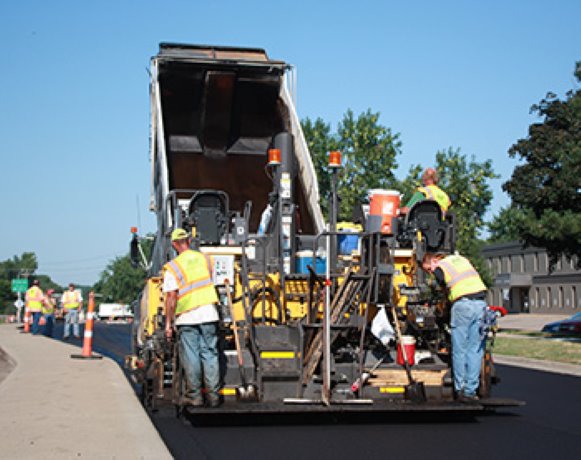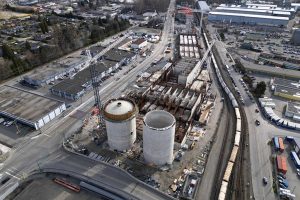The U.S. National Asphalt Paving Association (NAPA) has released the results of its 2009-2011 reclaimed and recycled materials survey, administered in partnership with the U.S. Federal Highway Administration (FHWA).
The survey indicates greater acceptance of reclaimed asphalt pavement (RAP), reclaimed asphalt shingles (RAS) and warm-mix asphalt used in U.S. roadways, and resulting significant energy and cost savings.
Margaret Cervarich, vice-president of advocacy for NAPA said the FHWA, NAPA and the state Departments of Transportation (DOT) want to maximize the use of recycled materials.
“We have billions of tonnes of asphalt in place on highways, and that means we don’t have to mine more,” she said.
“It’s already been processed once and it has good uniformity in a known quantity.”
In 2011, use of warm-mix asphalt reached a record high in the U.S. at 69 million tons, a 309 per cent increase over 2009.
Its saved 21.2 million barrels of liquid asphalt binder worth $2.2 billion.
About 66.7 million tons of RAP, a 19 per cent increase from 2009, and 1.2 million tons of RAS, up 52.5 per cent, were used in new pavements.
DOTs limit the amount of recycled material used in new road construction to 10 to 20 per cent, said Cervarich.
“The limitations go back to the history of using recycled materials,” she said.
“Everyone got comfortable with using a certain percentage, so there wasn’t a big urge to increase that ratio.”
NAPA sees potential in increasing the ratio, citing countries like Japan that use a minimum 50 per cent RAP in public roadways.
Research at the National Centre for Asphalt Technology indicates the longevity of roads constructed with recycled materials is the same or better than pavement made of virgin materials, said Cervarich.
“They run heavy trucks on an oval track for 18 hours a day at the accelerated loading facility and found they could get 10 to 12 years out of recycled pavement,” she said.
“As this research comes out, FHWA and DOTs will likely become more comfortable with higher recycled contents.”
Jack Davidson, president of the B.C. Road Builders and Heavy Construction Association said Canada is just starting to catch up.
There are significant cost savings in oil recovery and reduced aggregate transportation costs.
“There’s a lot of aggregate in RAP. It saves the environment in digging rocks, crushing them up and transferring them, which all take a toll on air quality emissions,” he said.
“Right now, the closest aggregate source for Vancouver is Mission or Sechelt. They are moving it a long way…”
B.C.’s Ministry of Transportation recently introduced a new Standard Specification for the use of Recycled Asphalt Pavement.
“A contractor can potentially reuse up to 30 per cent of recycled asphalt in our roadways, depending on the type of road – numbered highway, secondary highway, or side road – and where the recycled asphalt will be placed—top lift or bottom lift,” said Ian Pilkington director, rehab & maintenance for the ministry.
The government tenders about 1.8 million square metres of hot-in-place recycling annually.
Other provincial contracts require use of a reclaiming machine, which pulverizes existing asphalt and mixes it with the underlying gravels to create a new base.
“Often we will require the contractor to mill off the existing asphalt and then place those millings on gravel side roads nearby,” he said.
“This reduces the maintenance costs on those roads by providing a hard surface that does not require constant dust control and re-gravelling.”
The ministry is currently researching the use of RAS and cold-in-place asphalt recycling, and comparing hot-in-place recycling and the traditional mill and fill process to determine GHG savings.
Gene Syvenky, chief executive officer for the Alberta Road Builders and Heavy Construction Association (ARHCA) said Alberta Transportation usually tenders 20 to 25 per cent recycled materials into road rehabilitation contracts.
Using recycled asphalt saves about $3 per tonne or about five per cent of total project costs, said Trent Bancarz, public affairs officer for Alberta Transportation.
Syvenky agreed about the environmental and cost-saving benefits, but said asphalt recycling can be prohibitive for small contractors.
Unused RAP must be stored for later use or dumped for a fee.
“Contractors are responsible for the storage. That usually isn’t a problem for larger contractors, but for smaller ones it can be a problem,” he said, adding it might be 10 years before a contractor can use it again.
The Alberta government conducted pilots into using other recycled road materials including crumbled tires.
“Those roads didn’t last long,” said Syvenky.
NAPA is collecting data for its third survey, which tracks usage for 2012 and will record the amount of recycled rubber in roadways. It will be available by the end of 2013.











Recent Comments
comments for this post are closed